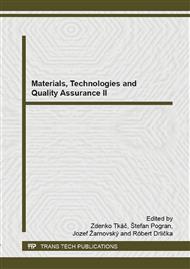p.1
p.11
p.19
p.27
p.35
p.43
p.53
p.61
Nitrogen Effect on Mechanical and Tribological Properties of STN 41 5230 Steel Surface Layer
Abstract:
The subject-matter of this article is using diffusion processes to obtain chemically stable compounds with a low reactivity and higher mechanical properties in material surface layer. These processes were implemented by remelting the surface of a given material in arc process using a TIG welding method. Nitrogen was used as an alloying element in experiments. The experiment assumed that the dissociation and ionization of gases, enabling the ionization of diffusion processes in the surface layer of remelted steel, will be achieved by means of electric arc. Conditions for the formation of hard and stable structures with required properties should have been created by enriching the surface layer. The STN 41 5230 steel was used in experiments. After remelting, samples were examined on hardness and relative abrasive wear resistance, which are crucial in terms of required properties of given surface layers. In addition to hardness values in the surface layer, also its behaviour inwards the material up to thermally unaffected base material was determined. When remelting in the environment containing nitrogen, the values of examined quantities increased.
Info:
Periodical:
Pages:
11-17
Citation:
Online since:
December 2014
Authors:
Keywords:
Price:
Сopyright:
© 2014 Trans Tech Publications Ltd. All Rights Reserved
Share:
Citation:


